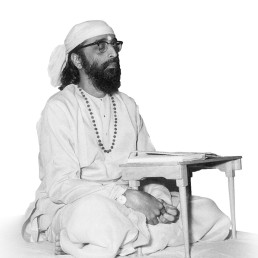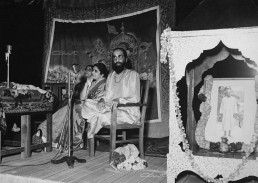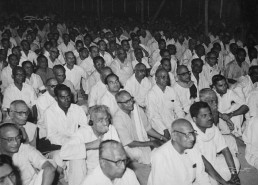
Jnana Yajna 100

Year & Dates:
February 01, 1962 to March 02, 1962

Yajna Topic:
Shrimad Bhagavad Gita- Chapter 7, 8 & 9

Place:
Chennai (Madras), India
“About nine years ago from Uttarkashi in the Himalayas, this Flow of Wisdom rushed down throughout the Bharath Varsha, sanctifying it, glorifying it, thus marking the beginning of a cultural revival in thIs great land,” remarked Smt. Radha Thyagarajan, with reverence and gratitude, in her inaugural address of Pujya Gurudev’s Centenary Jnana Yajna at the Mount Road yajnashala.
The carefully festooned and decorated pandal was in a heightened state of bliss after Pujya Gurudev was welcomed traditionally by Sri. M. Pethachi, the president of Chinmaya Mission, Madras. The saffron Om flag showered Pujya Gurudev with flower petals when Smt. Madhuram Rayaningar, the secretary of the yajna committee, hoisted it.
And, with majestic Grace, as two rows of bright children marked His path with loving respect and more flower petals, Pujya Gurudev ascended the stage. A melodious invocation by Smt. M. L. Vasantakumari, a stalwart of Carnatic music, moved all, and Mrs. Kothari, the president of the Madras yajna committee, extended a warm welcome to Pujya Gurudev and the surging audience.
Spirituality, Hundredfold and Pure
“A lot of talk has been heard about the 100th yajna. It is a sheer accident that this is the 100th session of the talking of Swamiji. The 100th yagna is great only when it is connected with desire prompted motives for gaining heaven etc. But when it is done as a nishkama karma and when it is only a jnana yajna, the 100th yajna is neither less nor more significant than the first yagna.” Pujya Gurudev’s opening discourse on the inaugural day of the Centenary Jnana Yajna at Chennai was powerfully indicative of how outward achievements did not sway Him.
Diving into the heart of that jnana yajna, He prefaced: “We will not be discussing what the world outside is. We will not be discussing the world of objects – body, mind, or intellect. We shall be discussing of That because of which the eyes are able to see, but the eyes themselves cannot see, of That because of which the ears hear; that Spiritual entity, the final Truth alone, will be the theme of discussion here for this one month during this hundredth yajna.”
As He prepared the audience for deep thinking, Pujya Gurudev, with deft and eloquent brevity, sketched the outline of the first third of the Gita: “In the first chapter we see the hysterical Arjuna. The second chapter, the contents of the entire Geeta. The 3rd chapter gave us the Path of Action. The 4th and 5th explained as to how from, the path of action we are to slowly withdraw and meditate upon the Highest, The 6th explained to us the technique of meditation. In logical development, He had explained to Arjuna in 7th, 8th and 9th what exactly is the highest Ideal upon which he must meditate and reach. The destination or the goal has been discussed and described very clearly and scientifically. This is the theme we will be taking here.”
The mornings of that enriching month of Yajna was devoted to Pujya Gurudev’s analysis of Shree Vidyaranya Panchadashi Chapter 14, the Vidyananda Prakarana. Open only to serious sadhaka members, that chapter which detailed the bliss of a realized Brahmavid quoting almost all major Upanishads, revealed Pujya Gurudev’s Vedantic depths.
The spiritually eminent Centenary Jnana Yajna was a grateful offering born of deep surrender to a beloved Guru, organized by an inspired all-women yajna committee.
A Meditation Minute:
निष्क्रिया करुणा क्वापि सफला न भविष्यति । इति मत्वा सर्वदैव कर्मणि वर्तते यतिः ॥३॥
niṣkriyā karuṇā kvāpi saphalā na bhaviṣyati । iti matvā sarvadaiva karmaṇi vartate yatiḥ ॥3॥
- Knowing fully well that nowhere does passive compassion serve any purpose, he always remains engaged in Karma.
We prostrate at the Lotus Feet of Pujya Gurudev, awed by how He embodied the path of active spiritual evolution, ‘working’ even though He was beyond the field of actions. His clarion call to aggressive goodness, untiring seva, and selfless unfoldment continues resounding and redirecting seekers everywhere.
Photo Gallery

“Think,” Says Pujya Gurudev
To the Jnaani “Supremely dear am I.” Love is measured by the amount of identification the lover has gained with the beloved. Self-surrender is the tune in which the song of love is truly sung. Selflessness is the key in which the duet of love is played. Love demands “giving without expecting any return,” at all times, in all circumstances. With this understanding of the nature of true selfless-love, when one tries to understand the attitude of the Gyani towards the Self, it is but true to say that, indeed, a Gyani alone knows how to love so well and so thoroughly.
From Tyagi Magazine
Each teacher comes and marks out on the black-board different designs which represent the design of knowledge that each teacher has in his bosom. But all of them were chalked out and executed on the same changeless black-board, which illumines the mathematical calculations, the geographical data, the chemical formulae, and the historical facts, in turn.
Similarly, the changing world of the unmanifested must all have one Changeless Substratum “that which is not destroyed by the destruction of all beings”. When in the evening the students and teachers have left the classroom the black-board still remains. This principle of Pure-Consciousness, Itself unmanifest-inasmuch as it is not perceivable by the sense-organs or comprehensible by the mind and intellect is indicated here when Lord declares “beyond this unmanifested, there is the other Eternal Existence, the Unmanifest”.
From Tyagi Magazine
Be it “a leaf, a flower, a fruit, or water,” it is insignificant what you offer: be it a golden temple, or be it a dry leaf, “whosoever with devotion offers” whatever be the offering, the Lord of Brindavan assures “that I accept”. For, when lovingly given it becomes “a devout gift” and when it is offered by a sincere “pure minded” student, the Lord has to accept it.
From Tyagi Magazine
Can Women study Scriptures?
The debate over whether women can engage with the teachings of the Upanishads and the Gita is unfounded, as there is no restriction on women studying these scriptures, with many Upanishads being transmitted by men to women historically. In fact, the scriptures themselves are often personified as feminine, emphasizing the crucial role of women in preserving and transmitting cultural knowledge.




